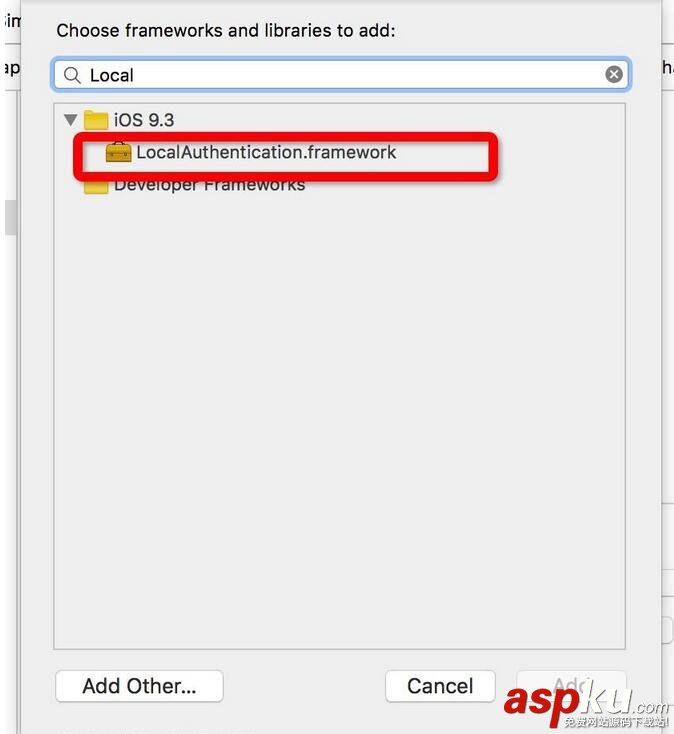指紋驗(yàn)證這個(gè)功能現(xiàn)在在一些app中經(jīng)常常見(jiàn),常常與數(shù)字解鎖,手勢(shì)解鎖聯(lián)合起來(lái)使用。前幾天接到說(shuō)實(shí)現(xiàn)一個(gè)指紋驗(yàn)證的功能,搗鼓了挺久,然后今天,我就簡(jiǎn)單的介紹下指紋驗(yàn)證,會(huì)做個(gè)簡(jiǎn)單的demo實(shí)現(xiàn)一下基本的功能。
支持系統(tǒng)和機(jī)型:iOS系統(tǒng)的指紋識(shí)別功能最低支持的機(jī)型為iPhone 5s,最低支持系統(tǒng)為iOS 8。實(shí)現(xiàn)起來(lái)呢,其實(shí)還是很簡(jiǎn)單的,下面我們就用純代碼方式實(shí)現(xiàn)一個(gè)簡(jiǎn)單的demo1。
第一部分:調(diào)用原生服務(wù)實(shí)現(xiàn)指紋驗(yàn)證
這部分了解個(gè)大概就可以了
第一步:添加LocalAuthentication.framework庫(kù)



第二步:在appdelegate.m中添加代碼
這個(gè)不說(shuō)其實(shí)大家也都知道的吧。
#import "AppDelegate.h"#import "ViewController.h"@interface AppDelegate ()@end@implementation AppDelegate- (BOOL)application:(UIApplication *)application didFinishLaunchingWithOptions:(NSDictionary *)launchOptions { //appdelegate _window = [[UIWindow alloc]initWithFrame:[UIScreen mainScreen].bounds]; _window.backgroundColor = [UIColor whiteColor]; [_window makeKeyAndVisible]; ViewController *vc = [[ViewController alloc]init]; UINavigationController *na = [[UINavigationController alloc]initWithRootViewController:vc]; _window.rootViewController = na; return YES;} 第三步
引入頭文件
#import <LocalAuthentication/LocalAuthentication.h>
第四步:實(shí)現(xiàn)指紋驗(yàn)證
這一步就是很重要的地方了,在- (void)viewDidLoad中寫(xiě)入驗(yàn)證實(shí)現(xiàn)的代碼,這里只有兩步,因?yàn)長(zhǎng)AContext在官方文檔中只有兩個(gè)方法:
-canEvaluatePolicy:error: //-(BOOL)canEvaluatePolicy:(LAPolicy)policy error:(NSError * __autoreleasing *)error __attribute__((swift_error(none))); -evaluatePolicy:localizedReason:reply: //- (void)evaluatePolicy:(LAPolicy)policy localizedReason:(NSString *)localizedReason reply:(void(^)(BOOL success, NSError * __nullable error))reply;
一個(gè)是判斷設(shè)備是否支持touchid,一個(gè)是進(jìn)行驗(yàn)證返回不同的結(jié)果,之前在網(wǎng)上經(jīng)常可以一些文章中寫(xiě)了,指紋驗(yàn)證的第一步都是先判斷設(shè)備的系統(tǒng)版本等等,現(xiàn)在似乎都不需要了,只要調(diào)用該方法就可以了。全部的代碼 如下:
- (void)viewDidLoad { [super viewDidLoad]; self.title = @"TouchIDSimpleDemoOne"; LAContext *context = [[LAContext alloc]init]; NSError *error; NSString *result = @"需要你身份驗(yàn)證呢"; if ([context canEvaluatePolicy:LAPolicyDeviceOwnerAuthenticationWithBiometrics error:&error]) { [context evaluatePolicy:LAPolicyDeviceOwnerAuthenticationWithBiometrics localizedReason:result reply:^(BOOL success, NSError *error) { if (success) { //驗(yàn)證成功,主線程處理UI //這個(gè)地方呢就是寫(xiě)一些驗(yàn)證成功之后需要做些什么事情的代碼。 NSLog(@"驗(yàn)證成功"); } else { //以下是一些驗(yàn)證失敗的原因啥的 NSLog(@"%@",error.localizedDescription); switch (error.code) { case LAErrorSystemCancel: { NSLog(@"切換到其他APP,系統(tǒng)取消驗(yàn)證Touch ID"); //切換到其他APP,系統(tǒng)取消驗(yàn)證Touch ID break; } case LAErrorUserCancel: { NSLog(@"用戶取消驗(yàn)證Touch ID"); //用戶取消驗(yàn)證Touch ID break; } case LAErrorUserFallback: { NSLog(@"用戶選擇輸入密碼"); [[NSOperationQueue mainQueue] addOperationWithBlock:^{ //用戶選擇其他驗(yàn)證方式,切換主線程處理 }]; break; } default: { NSLog(@"LAErrorAuthenticationFailed,授權(quán)失敗"); //授權(quán)失敗 [[NSOperationQueue mainQueue] addOperationWithBlock:^{ //其他情況,切換主線程處理 }]; break; } } } }]; }else { //不支持指紋識(shí)別,LOG出錯(cuò)誤詳情 switch (error.code) { case LAErrorTouchIDNotEnrolled: { NSLog(@"設(shè)備Touch ID不可用,用戶未錄入"); break; } case LAErrorPasscodeNotSet: { NSLog(@"系統(tǒng)未設(shè)置密碼"); break; } case LAErrorTouchIDNotAvailable: { NSLog(@"設(shè)備Touch ID不可用,例如未打開(kāi)"); break; } default: { NSLog(@"系統(tǒng)未設(shè)置密碼"); break; } } NSLog(@"%@",error.localizedDescription); } }
//指紋驗(yàn)證返回值typedef NS_ENUM(NSInteger, LAError){ /// Authentication was not successful, because user failed to provide valid credentials. LAErrorAuthenticationFailed = kLAErrorAuthenticationFailed, /// Authentication was canceled by user (e.g. tapped Cancel button). LAErrorUserCancel = kLAErrorUserCancel, /// Authentication was canceled, because the user tapped the fallback button (Enter Password). LAErrorUserFallback = kLAErrorUserFallback, /// Authentication was canceled by system (e.g. another application went to foreground). LAErrorSystemCancel = kLAErrorSystemCancel, /// Authentication could not start, because passcode is not set on the device. LAErrorPasscodeNotSet = kLAErrorPasscodeNotSet, /// Authentication could not start, because Touch ID is not available on the device. LAErrorTouchIDNotAvailable = kLAErrorTouchIDNotAvailable, /// Authentication could not start, because Touch ID has no enrolled fingers. LAErrorTouchIDNotEnrolled = kLAErrorTouchIDNotEnrolled, /// Authentication was not successful, because there were too many failed Touch ID attempts and /// Touch ID is now locked. Passcode is required to unlock Touch ID, e.g. evaluating /// LAPolicyDeviceOwnerAuthenticationWithBiometrics will ask for passcode as a prerequisite. LAErrorTouchIDLockout NS_ENUM_AVAILABLE(10_11, 9_0) = kLAErrorTouchIDLockout, /// Authentication was canceled by application (e.g. invalidate was called while /// authentication was in progress). LAErrorAppCancel NS_ENUM_AVAILABLE(10_11, 9_0) = kLAErrorAppCancel, /// LAContext passed to this call has been previously invalidated. LAErrorInvalidContext NS_ENUM_AVAILABLE(10_11, 9_0) = kLAErrorInvalidContext} NS_ENUM_AVAILABLE(10_10, 8_0);以上呢,就是一個(gè)簡(jiǎn)單的demo了,可能有些小問(wèn)題,到時(shí)候需要的話可以自調(diào)整。這里附上這個(gè)demo的guithub鏈接看這里看這里,鏈接在這呢。
第二部分:利用現(xiàn)有的第三方組件實(shí)現(xiàn)
這個(gè)部分可以好好學(xué)習(xí)一下。
在這里呢,我要推薦一個(gè)別人寫(xiě)的一個(gè)第三方的組件,就是[WJTouchID](https://github.com/hu670014125/WJTouchID);這個(gè)控件的話,在這個(gè)鏈接上其實(shí)已經(jīng)有寫(xiě)出怎么用了,其實(shí)不需要我再都說(shuō)什么,但是我還是要說(shuō)下吧。
調(diào)用時(shí)只需要一兩行代碼調(diào)用,但是回調(diào)函數(shù)還是需要寫(xiě)不少東西的。。。
1:復(fù)制文件進(jìn)去

2:引入頭文件
#import "WJTouchID.h"
3:遵守協(xié)議
@interface ViewController ()<WJTouchIDDelegate>
4: 創(chuàng)建對(duì)象
@property (nonatomic, strong) WJTouchID *touchID;
5:調(diào)用
- (void)viewDidLoad { [super viewDidLoad]; //初始化 WJTouchID *touchid = [[WJTouchID alloc]init]; [touchid startWJTouchIDWithMessage:WJNotice(@"自定義信息", @"The Custom Message") fallbackTitle:WJNotice(@"", @"Fallback Title") delegate:self]; self.touchID = touchid;}6:實(shí)現(xiàn)回調(diào)函數(shù)
@required //TouchID驗(yàn)證成功- (void)WJTouchIDAuthorizeSuccess; //TouchID驗(yàn)證失敗- (void)WJTouchIDAuthorizeFailure;@optional //當(dāng)前設(shè)備不支持指紋識(shí)別- (void)WJTouchIDIsNotSupport; //當(dāng)前軟件被掛起取消了授權(quán)(如突然來(lái)了電話,應(yīng)用進(jìn)入前臺(tái))- (void)WJTouchIDAuthorizeErrorAppCancel; //取消TouchID驗(yàn)證 (用戶點(diǎn)擊了取消)- (void)WJTouchIDAuthorizeErrorUserCancel; //在TouchID對(duì)話框中點(diǎn)擊輸入密碼按鈕- (void)WJTouchIDAuthorizeErrorUserFallback; //在驗(yàn)證的TouchID的過(guò)程中被系統(tǒng)取消 例如突然來(lái)電話、按了Home鍵、鎖屏...- (void)WJTouchIDAuthorizeErrorSystemCancel; //無(wú)法啟用TouchID,設(shè)備沒(méi)有設(shè)置密碼- (void)WJTouchIDAuthorizeErrorPasscodeNotSet; //多次連續(xù)使用Touch ID失敗,Touch ID被鎖,需要用戶輸入密碼解鎖- (void)WJTouchIDAuthorizeErrorTouchIDLockout; //當(dāng)前軟件被掛起取消了授權(quán) (授權(quán)過(guò)程中,LAContext對(duì)象被釋)- (void)WJTouchIDAuthorizeErrorInvalidContext; //設(shè)備沒(méi)有錄入TouchID,無(wú)法啟用TouchID- (void)WJTouchIDAuthorizeErrorTouchIDNotEnrolled; //該設(shè)備的TouchID無(wú)效- (void)WJTouchIDAuthorizeErrorTouchIDNotAvailable;
這些方法實(shí)現(xiàn)結(jié)束后呢,這個(gè)功能也基本上算是完成了。因?yàn)楹孟衿L(zhǎng)了,看得人肯定也嫌煩,所以我準(zhǔn)備另寫(xiě)一篇做一個(gè)在app被喚醒的時(shí)候啟動(dòng)指紋驗(yàn)證,分別用彈出控制器和彈出自定義view這兩個(gè)方式來(lái)實(shí)現(xiàn),感興趣的話可以看下。
以上就是本文的全部?jī)?nèi)容,希望對(duì)大家的學(xué)習(xí)有所幫助,也希望大家多多支持VEVB武林網(wǎng)。
新聞熱點(diǎn)
疑難解答
圖片精選
網(wǎng)友關(guān)注